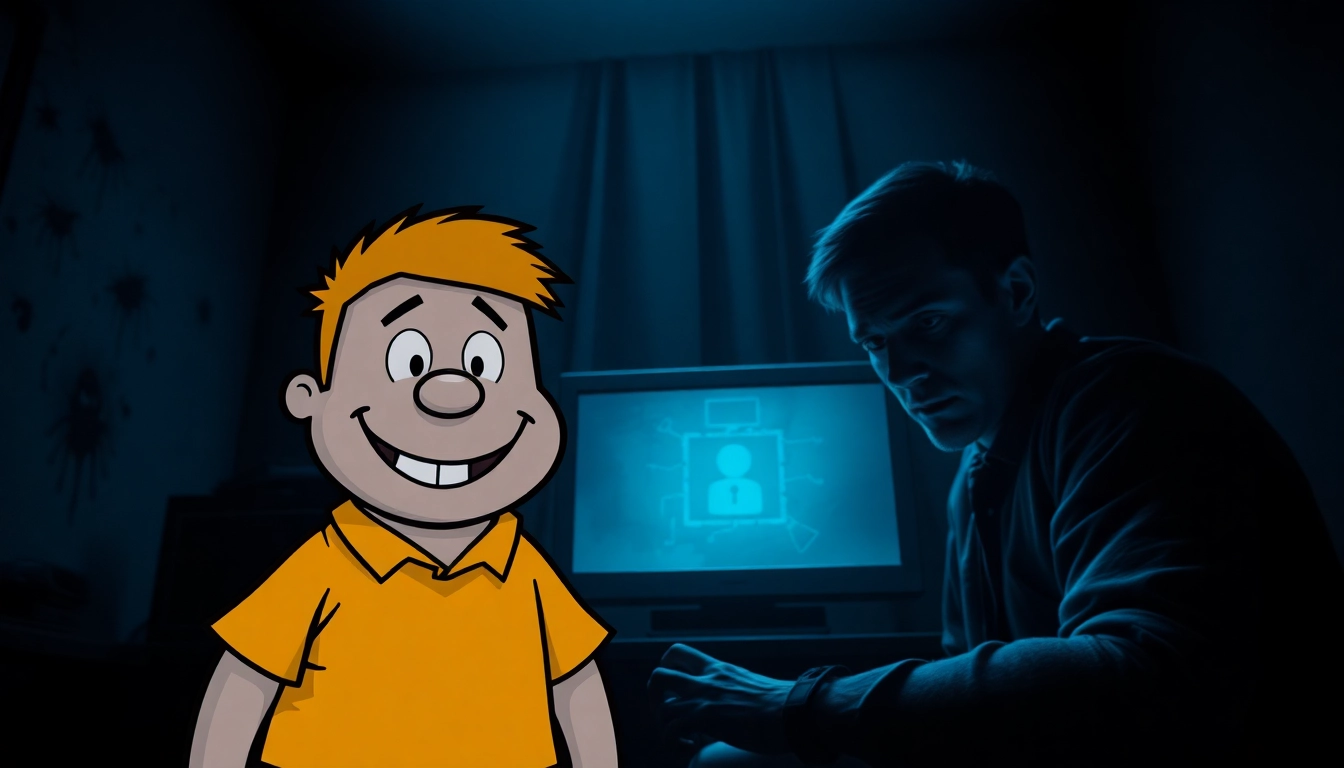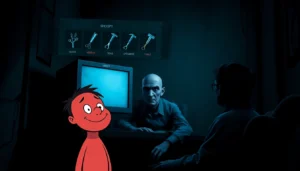Overview and Context: BloodMoney – A Psychological Horror Clicker Experience
In the realm of indie horror games, few titles push the boundaries of psychological discomfort and moral questioning as effectively as BloodMoney. This dark and unsettling clicker game introduces players to a disturbing scenario where each click not only earns money but also chips away at moral integrity and empathy. Set against a desperate backdrop, the game challenges players to confront their own ethics as they navigate a treacherous landscape of pain, profit, and psychological horror. BloodMoney’s innovative mechanics, layered narrative, and visceral visuals make it a standout in the genre, captivating players with its deeply immersive and morally complex gameplay.
The Core Mechanics: Clicking, Upgrades, and Moral Dilemmas
Clicking for Survival
At its core, BloodMoney is a clicker game — a genre known for its simple yet addictive mechanics. Players are tasked with clicking on Harvey, a cheerful and seemingly innocent character, to generate money needed for a critical medical procedure. The setup is straightforward: each click produces a dollar, but at a hidden cost. Harvey endures increasing pain with every interaction, and the visual cues grow darker and more disturbing as the game progresses.
Upgrade System and Visual Consequences
As players accumulate funds, they can purchase upgrades from the in-game shop. These upgrades include tools like needles, scissors, and hammers, each designed to boost earnings. However, the more violent and unsettling the tool, the greater the psychological toll on Harvey. The game cleverly ties visual and emotional consequences to each upgrade—Harvey’s appearance degrades, and his reactions become increasingly distressed. This creates a risk-reward dynamic: maximize profits at the expense of Harvey’s suffering, or choose a path of minimal harm, preserving some semblance of innocence.
Multiple Pathways and Playstyles
BloodMoney doesn’t enforce a single moral path. Instead, it subtly tracks how players approach their clicks and upgrades, unlocking different endings based on their choices. Whether players opt for minimal harm, moderate violence, or complete ruthlessness, their decisions shape Harvey’s fate and the story’s conclusion. This layered gameplay encourages multiple playthroughs, each revealing new facets of the game’s dark narrative.
The Dark Narrative of BloodMoney: Harvey’s Character and the Moral Descent
Introducing Harvey: The Innocent Face of Horror
Harvey appears to be a cheerful, almost childlike figure who offers a seemingly simple transaction: click to earn money. Early in the game, his innocence is palpable, and players might even feel a twinge of guilt for causing him pain. However, as the game unfolds, subtle details hint that Harvey might not fully comprehend what is happening to him. His surprised reactions to more violent tools, such as the hammer, suggest he is unaware of their true purpose, adding a complex layer to the moral dilemma.
The Psychological Journey and Moral Decline
BloodMoney masterfully captures the duality of human nature. The player’s actions—clicking, upgrading, and choosing tools—represent a descent into moral ambiguity. The cheerful veneer of Harvey’s character gradually fades, replaced by fear and suffering, mirroring the player’s own moral erosion. The game asks provocative questions: How much pain are you willing to inflict to save yourself? Is profit worth the human cost? These choices force players to confront uncomfortable truths about empathy, greed, and the capacity for cruelty under pressure.
Harvey’s Proposition and the Player’s Dilemma
As the narrative progresses, Harvey offers a desperate proposition: continue clicking and upgrading, or stop to minimize suffering. The tension intensifies when players realize that their actions directly influence Harvey’s well-being and the game’s ending. The moral complexity deepens when considering whether Harvey truly understands what is happening or is simply a pawn in a darker game. This ambiguity challenges players to reflect on their own moral boundaries and the consequences of their choices.
Visual and Emotional Impact: Creating an Unsettling Atmosphere
Subtle Visual Cues and Atmosphere
BloodMoney employs minimalist yet powerful visuals to evoke a growing sense of dread. Harvey’s facial expressions, body language, and reactions subtly shift as he endures more pain. The game uses color palettes that transition from bright and cheerful to dark and grim, reinforcing the emotional weight of each decision. Visual cues like Harvey’s trembling hands, widened eyes, or trembling voice dialogue serve as a mirror to the player’s moral journey.
Sound Design and Psychological Horror
The soundscape complements the visuals perfectly—soft, cheerful music initially, gradually replaced by unsettling noises, distorted whispers, and visceral sounds of pain. These auditory elements heighten the psychological horror, making players acutely aware of the moral toll of their actions. The game’s atmosphere is meticulously crafted to evoke discomfort, forcing players to question their choices at every turn.
Visual Consequences of Upgrades
Each upgrade visibly impacts Harvey’s appearance and environment. For instance, using a needle results in a slight change, but adopting a hammer or knife causes more grotesque transformations—Harvey’s features contort, his clothing becomes tattered, and his eyes express increasing terror. These visual changes serve as a visceral reminder of the cost of greed and efficiency, making the moral stakes tangible and disturbing.
Player Choices and Multiple Endings: Morality in Focus
The Path to the Endings
BloodMoney culminates in three distinct endings, each reflecting the player’s moral stance. The game tracks your choices subtly, influencing which conclusion you unlock. The three endings are:
- The Good Ending: Achieved by minimizing Harvey’s suffering, avoiding violent tools, and resisting greed. Harvey retains some innocence, and the story emphasizes compassion and moral integrity.
- The Normal Ending: A moderate approach where some violence is tolerated, and Harvey’s suffering is balanced against the urgency of reaching the financial goal.
- The Bad Ending: Maximize profit regardless of suffering—using violent tools and neglecting Harvey’s distress. Harvey’s appearance is grotesque, and the story grimly underscores the destructive power of greed and moral indifference.
The Final Choice and Its Impact
The game’s design ensures your choices feel consequential. The final moments reveal how your approach to the clicking mechanic and upgrade selections determine Harvey’s fate and the narrative resolution. It’s a stark commentary on how moral compromise can lead to different personal and philosophical outcomes.
Community Insights and Player Reactions
Reactions to BloodMoney’s Dark Themes
The gaming community has responded passionately to BloodMoney’s provocative content. Many players express a mixture of fascination and discomfort, praising the game’s ability to evoke genuine emotional responses. Videos exploring the multiple endings, like the comprehensive walkthroughs explaining how to achieve each conclusion, have garnered significant attention, with viewers reflecting on the moral implications posed by the game.
Player Theories and Hidden Details
Observant players have uncovered subtle clues suggesting Harvey may not fully grasp what’s happening—his surprise at violent tools, for instance, implies a lack of understanding. Some theorize that the game intentionally blurs the lines between innocence and manipulation, raising questions about free will, ignorance, and moral agency. The community continues to debate whether Harvey is complicit or simply a victim of darker forces controlling the game’s mechanics.
Sharing Gameplay and Emotional Impact
Featured gameplay videos reveal diverse strategies—some players aim for the Good Ending by resisting violence, while others push towards maximum profit, regardless of the moral cost. The emotional responses captured, especially Harvey’s reactions, highlight the game’s power to evoke empathy and guilt, making it a memorable experience that lingers long after playtime ends.
The Psychological Depth: Exploring Human Nature and Morality
Testing Humanity’s Duality
BloodMoney functions as a mirror to the darker facets of human nature. It explores whether humans are inherently good or evil when faced with life-and-death situations. The game’s mechanics—balancing profit against suffering—serve as a metaphor for real-world moral dilemmas, such as healthcare prioritization, resource allocation, and the ethics of sacrifice.
Innocence versus Corruption
Harvey’s character embodies innocence, but as the game progresses, the player’s choices can corrupt this innocence. The game raises unsettling questions: Does the pursuit of survival justify moral compromise? Can empathy be maintained when survival instincts scream louder? These themes provoke a deep introspection, making BloodMoney not merely a game but a psychological experiment on morality.
Visual and Narrative Symbolism
The imagery—Harvey’s deteriorating appearance, the increasingly violent tools—symbolizes the corrupting influence of greed and desperation. The narrative deliberately blurs reality and morality, challenging players to reflect on their own values and the societal implications of their choices.
Conclusion: The Power of Moral Choices in Horror Gaming and the Dark Psychology of BloodMoney
BloodMoney stands out as a powerful testament to how video games can serve as tools for moral exploration and psychological reflection. Its innovative mechanics, layered storytelling, and visceral visuals create an experience that is both disturbing and thought-provoking. The game forces players to confront uncomfortable truths about their own morality—how far they are willing to go when their life is on the line.
By engaging with bloodmoney, players are invited into a dark psychological journey that challenges the very essence of human nature. Will you choose the path of compassion, or will greed blind you? The game’s multiple endings serve as stark reminders that every click, every decision, shapes your moral destiny—making BloodMoney an unforgettable exploration of morality’s fragile boundaries in the face of horror and desperation.
Ultimately, BloodMoney is not just a game; it’s a reflection of our own capacity for good and evil. Its power lies in its ability to make us question ourselves, revealing the thin line separating innocence from corruption. As you consider your choices, ask yourself: how far would you go for survival? The answer lies within the dark depths of your own morality, waiting to be uncovered with each click.
Connect with Us
For more insights into this psychological horror game and related titles, stay tuned. Dive into the unsettling world of bloodmoney and discover what it reveals about human nature. Remember, every click counts—both in the game and in understanding ourselves.
And if you’re eager for more dark, thought-provoking experiences, explore related games and community discussions, all centered around the haunting themes of morality, survival, and human psyche.
For further updates, gameplay analyses, and community insights, connect with us and share your journey through the shadows of BloodMoney.
Remember: your moral choices define your story. How far are you willing to go?





